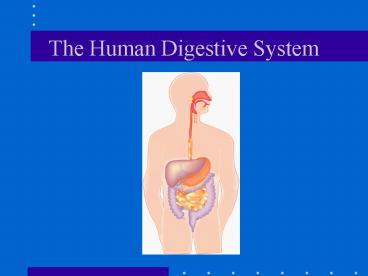The Human Digestive System - PowerPoint PPT Presentation
1 / 24
Title:
The Human Digestive System
Description:
3. Lining is covered in villi. 4. Epithelial cells of the intestinal lining have microvilli. ... Villus. The Villus. The Large Intestine. 1.5 m in length, 6 cm ... – PowerPoint PPT presentation
Number of Views:35
Avg rating:3.0/5.0
Title: The Human Digestive System
1
The Human Digestive System
2
The Human Digestive System
- The human digestive tract is similar to that of
the earthworm, in terms of both the anatomy and
physiology. - The digestive tract is actually a tube, with a
number of specialized organs along its path.
3
Digestive System continued
- If the tube was stretched out, it would be about
9 m in length.
4
Path of Ingested Food
- Oral Cavity (mouth)
- Pharynx (throat)
- Esophagus (gullet)
- Stomach
- Small intestine
- Large intestine
- Rectum
- Anus
5
Digestive Glands
- Along the digestive path, there are several
digestive glands that include the salivary
glands, the liver and the pancreas. - These glands produce secretions that enter the
tube via small tubes called ducts.
6
The Mouth and Pharynx
- When food enters the mouth there are two
important processes that occur - 1. Mechanical breakdown- grinding action of
teeth. - 2. Chemical digestion-action of saliva. Refer to
Handout-Saliva and Salivation.
Bolus
Bolus
7
Mouth and Pharynx continued.
- When the food has been chewed, moistened, and
turned into the bolus, it is pushed to the back
of the pharynx by the tongue. - When the bolus arrives at the back of the throat,
the swallowing reflex is activated. - Food is forced into the esophagus.
Bolus
Bolus
8
The Esophagus
- Food is pushed along the esophagus to the
stomach, by means of wave-like contractions
called peristalsis. - In peristalsis, muscles in front of the bolus
relax, and those behind the bolus contract. This
sends food ahead to the stomach. See handout
called Peristalsis and Segmentation.
Esophagus
9
The Stomach
- When the bolus reaches the stomach it encounters
a ring of muscle tissue called a sphincter. - Because of peristalsis, the sphincter relaxes and
food enters the stomach. - The stomach is a thick-walled muscular sac and
can hold more than 2 L of material. - Refer to handout- Stomach Structure and
Functions.
10
Chemical Digestion of Food
- Chemical breakdown of food begins in the stomach.
- Two types of glands are involved here
- 1. Pyloric Glands - These glands secrete mucus
that protects the stomach from enzymes and acids
i.e. prevents self-digestion.
11
Chemical Digestion of Food continued
- 2. Gastric Glands - produce gastric juice which
contains - (a) Hydrochloric Acid - pH 1.5-2.5
- (b) Pepsin- works best in an acid environment.
Breaks down large proteins into smaller chains of
amino acids called polypeptides.
12
Release of Gastric Juice
- 1. Sight, thought, smell - stimulation of the
brain causes gastric glands to release gastric
juice (GJ). - 2. Food touching stomach lining results in GJ
release. - 3. Food stretching stomach or certain substances
(protein, caffeine, alcohol), results in release
of the hormone gastrin, from the stomach lining.
Gastrin in turn stimulates release of GJ.
13
From Stomach to Intestine !
- In the stomach, food is turned into a soupy
material called chyme. - Chyme passes through the pyloric sphincter and
into the duodenum (the first part of the small
intestine). - This takes about 2-6 hours.
Duodenum
14
The Small Intestine (S.I.)
- The S.I. Is about 6.5 m long and 2.5 cm in
diameter. - S.I environment is alkaline.
- Most chemical digestion occurs in the S.I.
- Nearly all absorption occurs in the S.I.
- Peristalsis and segmentation move food and
digestive juices through the S.I.(see handout).
15
The Small Intestine (S.I.) cont.
- In the S.I., chyme is mixed with the following
- 1. Bile from the liver
- 2. Pancreatic juice from the pancreas.
- 3. Intestinal juice from the cells in the
intestinal wall. - The above secretions contain enzymes that
complete digestion.
16
Digestive Juices in the S.I.
Chyme from stomach
Pancreatic juice and enzymes
Secretin and cholecystokinin
17
Pancreas Secretions
- Two products
- 1. Pancreatic Juice- contains sodium bicarbonate,
that neutralizes the acid chyme. - 2. Pancreatic Enzymes- Three enzymes.
Pancreas
18
Pancreas Enzymes
- 1. Amylase -breaks down starch into maltose.
- 2. Proteases - two types trypsin and
chymotrypsin. Both act on large protein
molecules. - 3. Lipases - break down fats.
Pancreas
19
Bile
- Produced in liver and stored in the gall bladder.
- Bile release is stimulated by cholecystokinin.
- Bile travels to S.I. via bile duct, where it
breaks up fats and oils into small droplets. This
process is called emulsification.
Gall bladder
20
Intestinal Juice
- Intestinal glands produce this juice.
- Contains several enzymes
- Fats- fatty acids and glycerol.
- Carbohydrates-simple sugars.
- Protein-amino acids.
Intestinal glands
21
Absorption in the S.I.
- S.I. is the site of absorption.
- Simple sugars, amino acids, vitamins and minerals
are absorbed through the wall of the S.I. - Fatty acids and glycerol are absorbed by small
lymphatic vessels called lacteals.
S.I.
22
Absorption in the S.I. Cont.
- S.I. is an excellent absorption site
- 1. Very long(6.5m)-allows time for absorption to
occur. - 2. Highly folded lining.
- 3. Lining is covered in villi.
- 4. Epithelial cells of the intestinal lining have
microvilli..
Villus
23
The Villus
24
The Large Intestine
- 1.5 m in length, 6 cm in diameter.
- No digestion here !
- Reabsorption of water.
- Absorption of vitamins produced by bacteria (Vit.
K Vit. B). - Gets rid of indigestible material.
- Storage of feces.
Large Intestine































